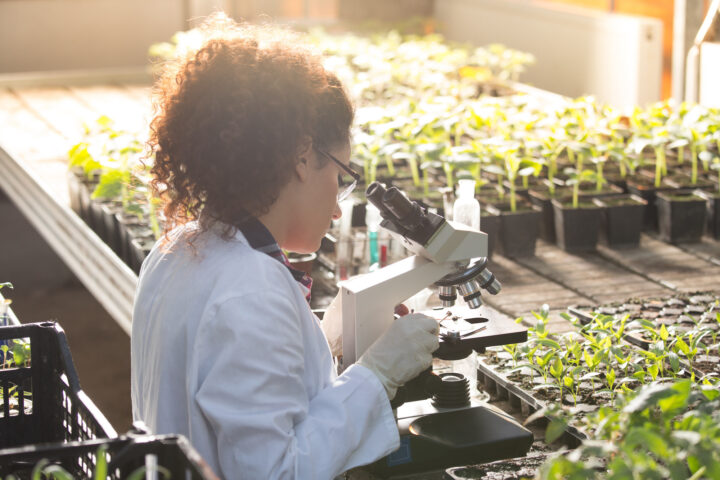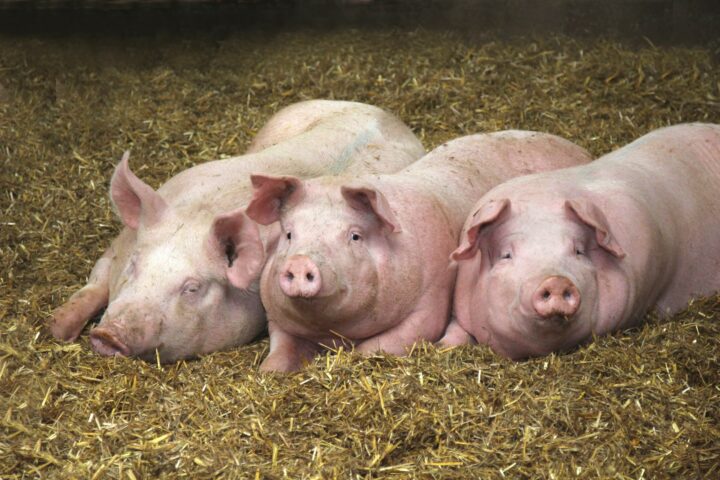
Biotechnology has only just begun
When Frank Schirrmacher cleared the pages of the Frankfurter Allgemeine Zeitung's arts section on 27 June 2000 to publish the human genome, which had just been deciphered for the first time, letter by letter over six pages, biotechnology came to the attention of the general public for the first time.
Tuesday, August 26, 2025
The sequencing of the human genome and many other organisms, including numerous crops, raised exaggerated expectations at the time: it was hoped that new therapies and improved crops would simply spring from the genetic blueprints. But these hopes were initially disappointed. Although genes responsible for countless traits and diseases could be identified quickly, it proved very difficult to put this knowledge into practice.
Until recently, many approaches failed because, although individual cells from humans, animals and plants can be easily modified, it is difficult to reach all the cells in an organism. Even gene editing in plants, which already enables enormous acceleration compared to classical genetic engineering, has been relatively cumbersome up to now because a completely new plant must first be grown from the appropriately modified plant cell. This usually does not work right away and has not yet been successful in many plants.
However, within the space of a few weeks, two research groups have now published approaches that could greatly simplify both plant breeding and cancer therapy because they reach all the relevant cells of an organism.
Tool in a virus
The first publication comes from the research group led by Jennifer Doudna, who was awarded the Nobel Prize in 2020 together with Emmanuelle Charpentier for the development of the CRISPR/Cas9 ‘gene scissors’.
Doudna and her team have developed gene scissors that fit into a widespread plant virus. When the virus is then introduced into the leaves of young plants with the help of a bacterium, the plant cells multiply it so that it can spread through the plant's vascular system to all cells, including the germ cells. The tool becomes active in every infected cell, so that within a few hours, a plant is created in which every cell carries the desired change. The germ cells are also affected, so that the seeds also carry the change. However, the virus is not transmitted.
This new technology reduces the conventional technique, which was already years faster than traditional genetic engineering, to a single step. No foreign genes are transferred or even temporarily integrated into the plant; instead, only the targeted change is triggered, which is then found in all descendants of this plant.
The implications are enormous. The virus used can replicate in approximately 1,000 plant species from around 80 plant families. The method therefore has the potential to extend genome editing to a broader spectrum of plants and further streamline the improvement of crops. Above all, however, it is so simple and fast that it should also be applicable to plants and varieties that have been neglected until now for cost reasons.
Gene editing is thus being taken to a new level. Changes will be faster, much less complicated and, above all, cheaper.
This will primarily benefit countries in Africa, Southeast Asia and South America, which are already struggling with climate change in the form of droughts, floods and new pests. Without high investment, they could now also focus on varieties and species that are not important for the global market but for the food security of their own populations. Government research institutions in numerous African, Asian and South American countries are already using gene editing to improve local varieties. A continuously updated overview can be found here. These countries are likely to adapt the new method quickly, making the achievements of modern biotechnology available to small farmers without financial burden.
Tool in a fat droplet
A similarly elegant method has just been presented for immunotherapies – an approach in which human immune cells are activated against infected or incorrectly programmed cells. This is a significant improvement on CAR-T cell therapy, which is currently used primarily to treat leukaemia and is very effective.
In conventional CAR-T cell therapy, T cells (which are white blood cells and part of the immune system) are genetically modified outside the body so that they can recognise and destroy tumour cells, defective immune cells, etc. To do this, they must first be multiplied and then returned to the patient's body via infusion.
The method is effective but requires specialised medical centres and laboratories that are not available everywhere. It takes weeks and can cost more than one hundred thousand euros. These obstacles have so far prevented widespread use.
Various new methods now allow CAR-T cells to be produced directly in the body. Here, too, the tools are transferred directly into the body – in the form of viruses or virus-like particles or even as lipid droplets measuring just a few nanometres in size that attach themselves specifically to T cells.
They transfer their contents, mRNA, into these cells. This causes a temporary change in the cells, but one that lasts long enough to ‘prime’ the T cells against the cancer cells. There are no permanent genetic changes. Studies in mice and monkeys have shown that this treatment is very effective and has no serious side effects.
A recently published study on monkeys using fat droplets shows that just a few hours after administration, the number of diseased cells was greatly reduced without any serious side effects. The effect lasted for about two weeks. Repeated applications led to almost complete elimination of cancer cells. What is particularly exciting is that after the destruction of the old B cells, new, ‘naive’ B cells emerged. This suggests a kind of restart of the immune system.
If this also works in humans, CAR-T treatment would become cheaper, faster and also applicable outside specialised clinics. It could therefore be extended to other diseases, such as autoimmune diseases such as lupus, rheumatism or multiple sclerosis.
Vaccination against metastases
Another advance is within reach, a breakthrough that could take the fear out of cancer. Around 90 percent of people diagnosed with cancer do not die from the primary tumour, which can be treated effectively if detected early, but from metastases. These occur when cancer cells spread from the tumour and begin to grow in other parts of the body.
After decades of research, several biotechnology companies are now developing personalised cancer vaccines tailored to the tumours of individual patients. Studies show that in skin cancer patients, for example, the risk of recurrence has been halved. The technology is based on mRNA and thus on the same principles as numerous COVID vaccines, but uses genetic information from the tumour to activate the immune system in a targeted manner.
For decades, this was considered science fiction, because every tumour has its own unique genetic signature that allows it to evade the human immune system's controls. Now it is on the verge of approval – and could revolutionise therapies where chemotherapy has been the only option until now.
Last but not least – bacteria instead of chemical factories
For decades, bacteria and other microorganisms have been producing vitamins, flavourings, amino acids and medicines in huge tanks called fermenters. However, this process has traditionally required carbohydrates such as sugar and starch: around 60 million tonnes of carbohydrates worldwide, mostly from agricultural production.
However, the first plants are now emerging in which CO2- or methane-consuming bacteria produce valuable raw materials – e.g. oils and surfactants for cosmetics, precursors for bioplastics or even fuels for aircraft. Other bacteria convert CO2 into combustible methane, which can be fed directly into biogas plants. CO2 dissolved in wastewater can be mineralised into calcite (CaCO₃) with the help of bacteria; hydrogen is produced in the process. Even for the degradation of plastic waste and highly toxic substances such as dioxin or so-called eternal chemicals (per- and polyfluoroalkyl substances, PFAS), bacteria have already been optimised using biotechnological methods.
These innovations bring a central promise of biotechnology within reach: not high technology for rich industrialised nations, but real benefits for many. What began with the publication of the human genome as the dawn of a new biotechnological age is now, almost a quarter of a century later, proving to be a slow but unstoppable transformation.
Author of the article: Ludger Weß, PhD in biochemistry and science journalist. As a profound expert in agricultural research, he is committed to a fact-based debate on new breeding technologies.
Kindly note:
We, a non-native editorial team value clear and faultless communication. At times we have to prioritize speed over perfection, utilizing tools, that are still learning.
We are deepL sorry for any observed stylistic or spelling errors.
Related articles

New Breeding Technologies (NBT)
Swiss agriculture is under pressure. Due to the changing climatic conditions and increasing weather extremes, the cultivation of many crops has become more demanding. Nevertheless, consumers, processors and trade expect regional and high-quality products at affordable prices.

How NZT makes popular varieties more resilient
New breeding technologies offer solutions – but they are simply being ignored in the current debate. Anyone who complains about the lack of flavour in strawberries must also be prepared to accept modern methods such as genome editing.

When the anti-genetic engineering lobby is in charge
A Tages-Anzeiger journalist gets caught in the threads of the anti-genetic engineering lobby and stumbles into unscientific territory. He writes about the fact that a politically controversial word is missing from a bill and embezzles a word himself when calling witnesses. A current example that shows how the choice of words can influence the perception of an issue.

What’s Really in Your Shopping Basket
Genetic engineering in our shopping basket? Yes – and much more often than we think. Whether it’s pasta, bread or vegetables: many of the everyday products we consume come from mutation breeding, which involves altering the genome and is considered safe. It’s high time to debunk the common myths.

Genomic breeding methods are not given a chance to prove themselves
Modern genomic breeding methods are legally classified as genetic engineering – and are therefore still effectively blocked. Yet we have been eating genetically modified plants for decades, just under the label of “classical mutagenesis.” The new, more precise techniques are regulated more strictly than the old ones, even though they are considered safer from a scientific perspective. A contradiction that urgently needs to be corrected. The EU is setting a good example.

No Pig Business: Why Testicle-Free Boars Are a Clear Win for Animal Welfare
New breeding methods are opening up new possibilities in both plant and animal breeding. They allow targeted genetic changes that can make animals more resilient, adaptable, and healthier.

Stagnation instead of progress: Switzerland risks falling behind in new breeding techniques
An overview article in Schweizer Bauer shows how much the new breeding methods are preoccupying farming circles. Once the consultation process on the federal law has been completed, a bill is expected – then it will become clear whether there is actually the political will to approve it.

